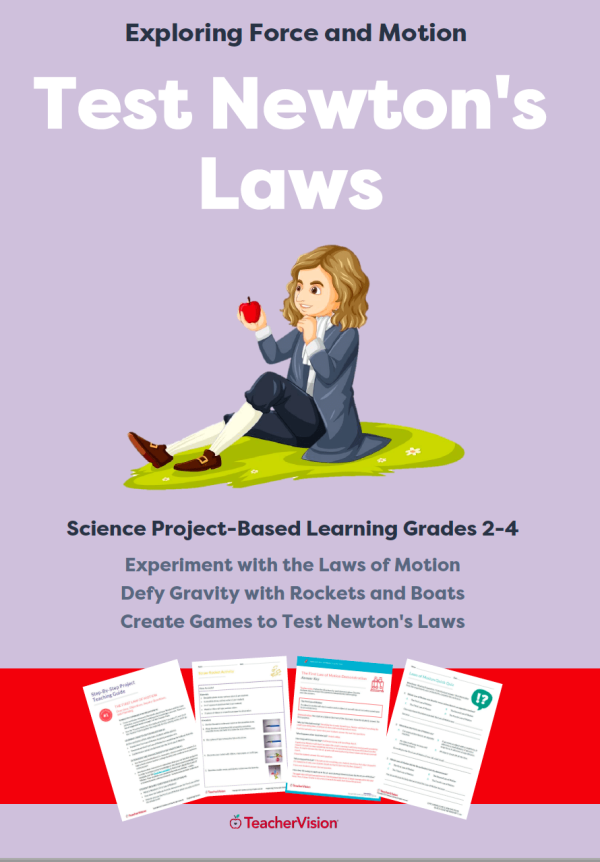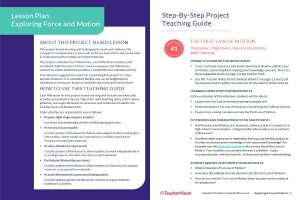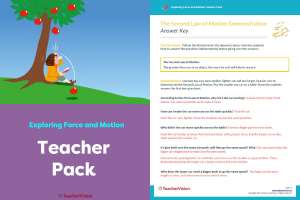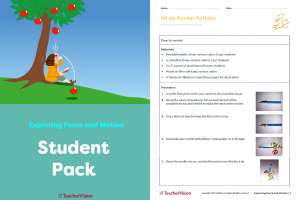
A Comprehensive Lesson on Newton's Laws of Motion
Experiment with forces and motion, test the Laws of Motion using straw rockets and sailboats, and design and create an interactive game with this science PBL unit.
Your students will discover Newton's Laws and play "Newton's Games" in this complete project-based learning unit on force and motion for 2nd to 4th grade science. They'll study Newton's Laws in detail by performing experiments, test their knowledge with straw rockets and mini sailboats, and design and create a game of "Balloon Cars" that enables them to synthesize and showcase their knowledge of force and motion.
What's Inside
Packed with hands-on inquiry-based activities, extensions and enhancements, cross-curricular independent and group work, and engaging and interactive challenges, this 64-page project-based unit comes complete with:
- For the Teacher: A complete Newton's Laws Lesson Plan with step-by-step instructions for all activities, teaching tips, assessment guidance, and inquiry questions.
- For Students: A full-color Student Pack complete with all of the printables and instructions students need for the experiments and activities - just print (or share) and teach!
A complete, ready-to-teach Teacher Pack that includes:
- Teacher versions of all the student printables with step-by-step annotations and notes for teaching Newton's Laws;
- Formative and summative assessments, answer keys, and a full project rubric;
- Instructions and guidance for the extension activities and project enhancements;
- Materials and resources lists, a PowerPoint presentation, and additional resources for lecture and presentation.
What's Included
Lesson Plan - Step-by-Step Project Guide
- Milestone 1: The First Law of Motion
- Milestone 2: The Second Law of Motion
- Milestone 3: The Third Law of Motion
- Milestone 4: Designing a Game
- Milestone 5: Game Day
Teacher and Student Resources
- List Books About Isaac Newton and the Laws of Motion
- Printable slides
- Newton’s Three Laws of Motion Answer Key
- First Law of Motion Demonstration Answer Key
- Teacher Notes for the Sailboat Activity
- Second Law of Motion Demonstration Answer Key
- Teacher Notes for the Straw Rocket Activity
- Third Law of Motion Demonstration Answer Key
- Teacher Notes for the Balloon Car Activity
- Laws of Motion Quick Quiz
- Laws of Motion Quick Quiz Answer Key
- Laws of Motion Summative Assessment
- Laws of Motion Summative Assessment Answer Key
- Laws of Motion Games RubricNewton’s Three Laws of Motion
- The First Law of Motion Demonstration
- Sailboat Activity
- Milestone #1 Inquiry Question
- Second Law of Motion Demonstration
- Straw Rocket Activity
- Newton’s Games Project Guidelines
- Materials and Object
- Milestone #2 Inquiry Question
- Third Law of Motion Demonstration
- Balloon Car Activity
- Set-Up Instructions
- Milestone #3 Inquiry Question
- Game Rules
- Milestone #4 Inquiry Question
- Game Day
- Milestone #5 Inquiry Question



OVERVIEW:
This project-based learning lesson is designed to support and reinforce the concepts taught as part of a lesson on Force and Motion. It is built around 5 inquiry-based milestones that incorporate cross-curricular hands-on projects, formative and summative assessments, independent and group activities, and extensions.
STUDENT/GROUP OUTPUT:
In the course of this project-based learning unit, students will:
- Perform independent and group inquiry-based experiments on each of Newton's Laws;
- Use their experiments and outcomes to test aspects of Newton's Laws in the classroom;
- Use classroom materials, craft supplies, and other materials to design vehicles for testing Newton's Laws (sailboats, straw rockets, and balloon cars);
- Synthesize acquired research and empirical knowledge into the creation and design of a series of "Newton's Games" based on the Laws of Motion;
- "Show what they know" by competing as a group in a "Newton's Games" derby-style classroom competition;
SUGGESTED SUBJECT PREREQUISITES:
Students will acquire necessary background knowledge of force and motion and Newton's Laws as part of this project, and instructional materials for providing that background are included in the Teacher Pack (PowerPoint presentation and Teaching Notes).
SEQUENCE AND PACING
This project-based unit is divided into 5 milestones. The minimum suggested duration for completing this project-based unit is 5 class periods. However, the unit is completely flexible can be lengthened or shortened as necessary or desired, based on available class time and interest level.
TECHNOLOGY RESOURCES (suggested):
- Internet access
- Microsoft Office PowerPoint, Google Slides, or other presentation software.
STANDARDS ALIGNMENT
These activities support the following NGSS curriculum standards:
- PS2.A (Forces and Motion)
- PS2.B (Types of Interactions)
- PS3.B (Conservation of Energy and Energy Transfer)
- PS3.C (Relationship Between Energy and Forces)
- ETS1.A (Defining and Delimiting an Engineering Problem)
- ETS1.B (Developing Possible Solutions)
- ETS1.C (Optimizing the Design Solution)







